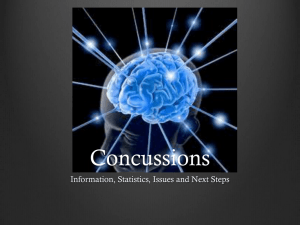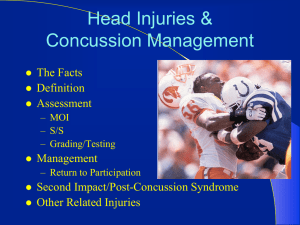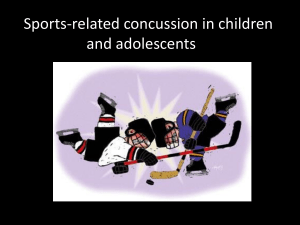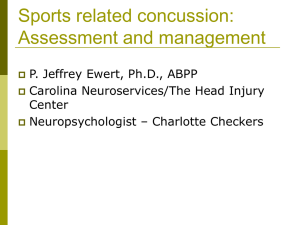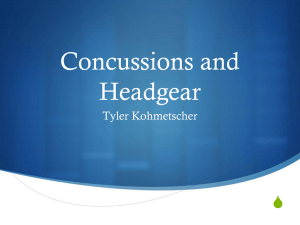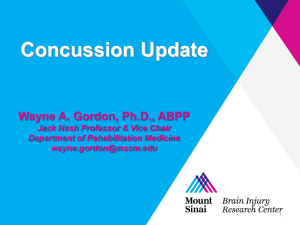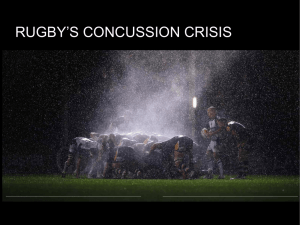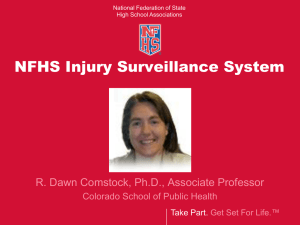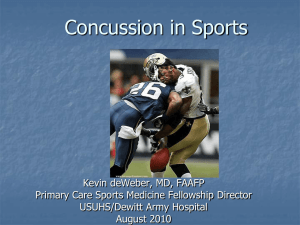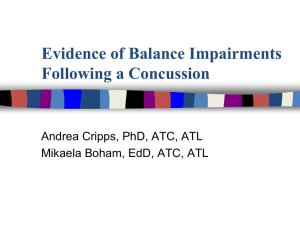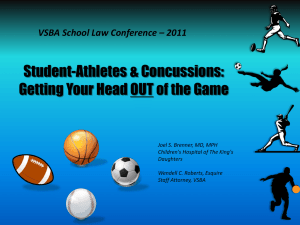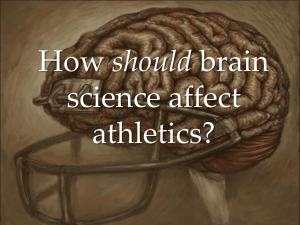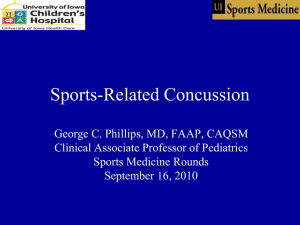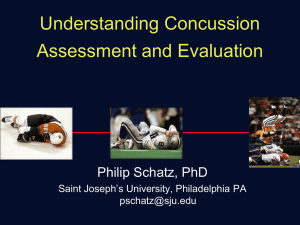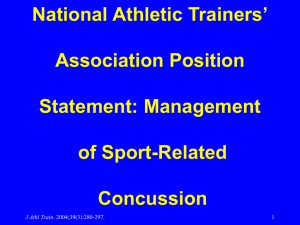2013 NATA Position Statement on Management of Sport
advertisement
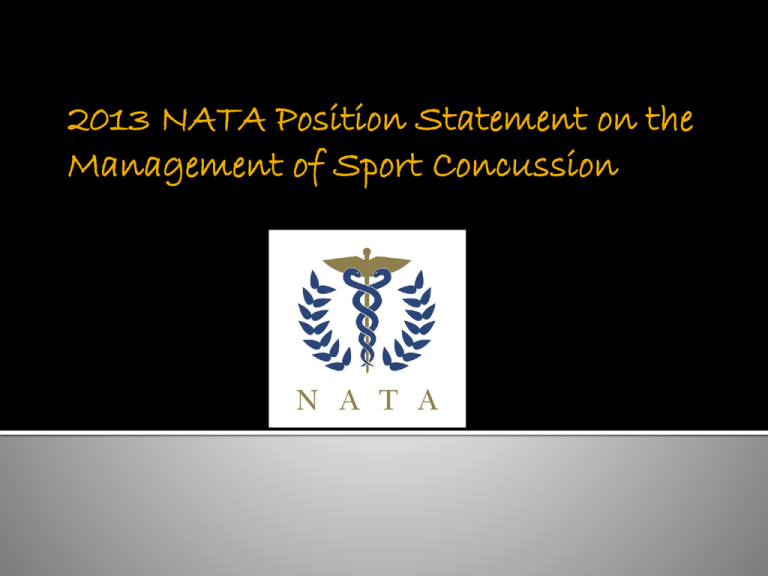
2013 NATA Position Statement on the Management of Sport Concussion Presented by: Jeanne Brown, MS, ATC-l Robert Cantu, MD Gerard A. Gioia, PhD Kevin Guskiewicz, PhD, ATC Jeffery Kutcher, MD Michael Palm, MBA, ATC Tamara Valovich-McLeod, PhD, ATC Available in written document by Summer 2013 – Winter 2014 (Journal of Athletic Training) Education and Prevention Documentation and Legal Aspects Evaluation and Return to Play Other Considerations: - Equipment - Pediatric Concussion - Home Care - Medications and Diet - Rest - Multiple Concussions “A trauma induced alteration in mental status that may or may not involve loss of consciousness”. Definition excludes the use of the terms: ding, bell – ringer, clearing the cobwebs, or other antiquated terms. Definition reflects that provided by the Zurich group. Proper terminology: concussion or MTBI (mild traumatic brain injury) Abide by educational requirements in state regulations and/or supervisory organization policies (i.e. NCAA or WIAA) Educate parents and coaches on: recognition, referral, proper return to participation, the physical and cognitive restrictions for concussed athletes, ramifications of improper concussion management, and prevention. Document potential modifying factors that could delay a return to play and athletes should be educated on the implications of these conditions as it affects their recovery. Work to educate coaches, athletes, and parents about the limitations in protective equipment regarding concussion prevention (i.e. helmets not designed to prevent concussion!). Read all warning labels associated with protective equipment 46 states do not have legislation in place re: concussion (Montana, Georgia, Alabama, WVA) Awareness of any and all governing bodies and their policies and procedures regarding concussions (i.e. state, NCAA/WIAA, school) Communicate the status of concussed athletes to a physician on a regular basis. Ensure proper documentation of the concussion evaluation, management and treatment, return to participation progression, and physician communications. High risk athletes should receive a baseline examination. The Baseline should include: - clinical history to include symptoms/score - neurological evaluation: motor control (balance), and neurocognitive function Baseline and post-injury exams should be administered in similar environments to maximize performance (review baselines for sub-optimal performances). An athlete suspected of sustaining a concussion should be removed from athletic participation and evaluated by a physician or their designate (i.e. ATC or PA). When a rapid assessment is necessary (i.e. during competition), brief concussion evaluation tools (SAC) should be used along with a motor control evaluation and assessment of symptoms to support the clinical evaluation. Once a concussion diagnosis is made, a physical exam should be performed and signs and symptoms monitored at least once a day. Symptoms How Assessed MENTAL STATUS How Assessed symptom Checklist / scale Level of consciousness, Attention/Concentration, Orientation, Memory SAC Previous Concussions EYE EXAMINATION Pre – participation examintation (PPE) Concusstion Related Personal History Eye movements with smooth pursuit (CN III, IV, VI), nystagmus (CN VIII), Pupillary reflex (CN II, III) Clinical examination MOTOR FUNCTION PPE Family History Strength evaluation of deltoid, biceps, triceps, wrist and finger flexors and extensors*; and pronator drift Clinical examination MOTOR CONTROL PPE Balance assessment BESS During the acute recovery stage, daily testing of neurocognitive function and motor control is not recommended until asymptomatic. No concussed athlete should return to physical activity without being evaluated and cleared by a physician or designate specifically trained in concussion evaluation and management. A concussed athlete should not be returned to athletic participation within the same day as injury. A physical exertion progression should be conducted only once an athlete demonstrates a normal clinical exam, symptom resolution, and return to baseline motor control and neurocognitive function (each stage separated by 24 hours of being asymptomatic): 1- No activity 23456- Light exercise Sport-specific activities without the treat of contact Non-contact training involving others Unrestricted training Unrestricted play Concussion grading scales should not be used for the purposes of injury management, but rather each injury should be evaluated and treated on a case-by-case basis Following injury resolution, the concussion may be retrospectively graded for the purposes of medical record documentation (i.e. mild, moderate, severe based on duration and intensity of symptoms). Helmets do help to prevent catastrophic head injuries, they do not significantly reduce the risk of cerebral concussions. Helmet use in high velocity sports (skiing, cycling) has been shown to protect against head and facial injury. Consistent evidence to support the use of mouth guards for concussion mitigation is not available. However, a properly fitted mouth guard does reduce dental injuries (!). The use of headbands in soccer is neither encouraged nor discouraged at this time, as their effectiveness is not clear based on the literature. Children and adolescents may take longer to recover than adults and require a more conservative return to play progression. Age-appropriate, validated assessment tools should be utilized with younger populations. Assessment of post-concussion symptoms in youth athletes should include age-validated standardized symptom scales and the formal input of parent observations. Pediatric athletes are undergoing continual brain and cognitive development and likely need more frequent updates to baseline assessments. Athletic trainers should work with school administrators and teachers to include appropriate academic accommodations into the concussion management plan. Those with a complex medical history may benefit from a referral to a neuropsychologist to administer and interpret neurocognitive assessments (i.e. multiple concussions, developmental disorders like ADD, ADHD, or psychiatric disorders like anxiety and depression. A standard concussion home-instruction form should be consistently used with a copy maintained in the medical record (oral and written instructions for home care should be given to the concussed athlete and to a responsible party). Concussed athletes should be instructed to avoid medications other than acetaminophen, unless prescribed by a physician. Concussed athletes should be instructed to avoid ingesting alcohol, illicit drugs, or other substances that might interfere with cognitive function and neurologic recovery. 1. 2. 3. 4. Name and Date of injury: Day, time and location of follow-up evaluation. Name of number of who to contact if symptoms worsen Symptoms ▪ ▪ ▪ ▪ ▪ ▪ ▪ ▪ ▪ ▪ ▪ Decreasing level of consciousness Increasing confusion Increasing irritability Loss of/fluctuating levels consciousness Numbness in the arms or legs Pupils become unequal in size Repeated vomiting Seizures Slurred or inability to speak Unable to recognize people or places Worsening Headache General Instructions to follow It is OK to: Use acetaminophen (Tylenol) for headaches Use ice pack on head and neck as needed for comfort Eat a carbohydrate rich diet Go to sleep Rest (no strenuous activity or sports) There is NO need to: Check eyes with flashlight Wake up every hour Test reflexes Stay in bed Do NOT: Drink alcohol Drive a car or operate machinery Engage in physical activity (i.e. exercise, weight lifting, physical education sport participation) that makes your symptoms worse Engage in mental activity (i.e. school, job, homework, computer games) that makes your symptoms worse Rest is currently the best practice for concussion recovery, so there is no need to wake the athlete during the night unless instructed by a physician. Athletes should be instructed to avoid any physical or mental exertion that exacerbates symptoms. In addition to exclusion from physical activity related to team activities, concussed studentathletes should be excused from PE classes. School administrators, counselors, and instructors should be made aware of the athlete’s injury with a recommendation for academic accommodation during the recovery period. Those not showing a typical progressive return to normal functioning following injury may benefit from other treatments. An athlete with a concussion should be instructed to eat a well-balanced diet that is nutritious in both quality and quantity – and to remain properly hydrated. A more conservative return to play strategy should be adopted for athletes with a concussion history. Referral to a physician with concussion specific training should be considered in athletes with multiple concussions when: - sustaining concussions with lessening force - demonstrates increasing severity of each injury - and/or demonstrates a change in baseline brain function Athletic Trainers should be particularly aware of the potential for Second Impact Syndrome in young athletes who sustain a 2nd concussion prior to complete resolution of the 1st injury. The athletic trainer should be aware of the potential for longterm consequences of multiple sub-concussive impacts. Dr. Steven Broglio, PhD, ATC – U of MI Committee Chairs and Co-Authors for the position statement: Robert Cantu, MD Gerard Gioia, PhD Kevin Guskiewicz, PhD, ATC Jeffery Kutcher, MD Michael Palm, MBA, ATC Tamara Valovich McLeod, PhD, ATC


